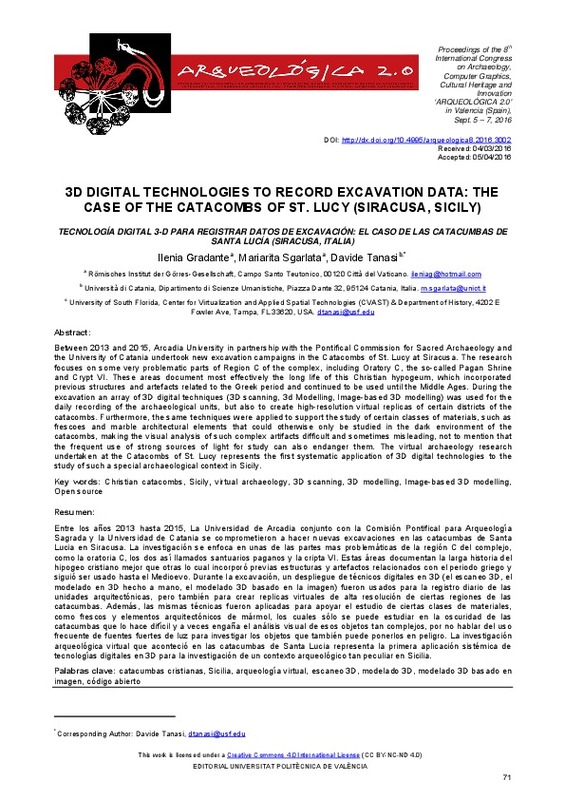JavaScript is disabled for your browser. Some features of this site may not work without it.
Buscar en RiuNet
Listar
Mi cuenta
Estadísticas
Ayuda RiuNet
Admin. UPV
3D DIGITAL TECHNOLOGIES TO RECORD EXCAVATION DATA: THE CASE OF THE CATACOMBS OF ST. LUCY (SIRACUSA, SICILY)
Mostrar el registro sencillo del ítem
Ficheros en el ítem
| dc.contributor.author | Gradante, Ilenia
|
es_ES |
| dc.contributor.author | Sgarlata, Mariarita
|
es_ES |
| dc.contributor.author | Tanasi, Davide
|
es_ES |
| dc.coverage.spatial | east=15.291702799999939; north=37.0728924; name=96100 Siracusa, Província de Siracusa, Itàlia | |
| dc.date.accessioned | 2017-07-21T07:39:31Z | |
| dc.date.available | 2017-07-21T07:39:31Z | |
| dc.date.issued | 2016-10-27 | |
| dc.identifier.isbn | 9788490484555 | |
| dc.identifier.uri | http://hdl.handle.net/10251/85573 | |
| dc.description.abstract | [EN] Between 2013 and 2015, Arcadia University in partnership with the Pontifical Commission for Sacred Archaeology and the University of Catania undertook new excavation campaigns in the Catacombs of St. Lucy at Siracusa. The research focuses on some very problematic parts of Region C of the complex, including Oratory C, the so-called Pagan Shrine and Crypt VI. These areas document most effectively the long life of this Christian hypogeum, which incorporated previous structures and artefacts related to the Greek period and continued to be used until the Middle Ages. During the excavation an array of 3D digital techniques (3D scanning, 3d Modelling, Image-based 3D modelling) was used for the daily recording of the archaeological units, but also to create high-resolution virtual replicas of certain districts of the catacombs. Furthermore, the same techniques were applied to support the study of certain classes of materials, such as frescoes and marble architectural elements that could otherwise only be studied in the dark environment of the catacombs, making the visual analysis of such complex artifacts difficult and sometimes misleading, not to mention that the frequent use of strong sources of light for study can also endanger them. The virtual archaeology research undertaken at the Catacombs of St. Lucy represents the first systematic application of 3D digital technologies to the study of such a special archaeological context in Sicily. | es_ES |
| dc.description.abstract | [ES] Entre los años 2013 hasta 2015, La Universidad de Arcadia conjunto con la Comisión Pontifical para Arqueología Sagrada y la Universidad de Catania se comprometieron a hacer nuevas excavaciones en las catacumbas de Santa Lucia en Siracusa. La investigación se enfoca en unas de las partes mas problemáticas de la región C del complejo, como la oratoria C, los dos así llamados santuarios paganos y la cripta VI. Estas áreas documentan la larga historia del hipogeo cristiano mejor que otras lo cual incorporó previas estructuras y artefactos relacionados con el periodo griego y siguió ser usado hasta el Medioevo. Durante la excavación, un despliegue de técnicos digitales en 3D (el escaneo 3D, el modelado en 3D hecho a mano, el modelado 3D basado en la imagen) fueron usados para la registro diario de las unidades arquitectónicas, pero también para crear replicas virtuales de alta resolución de ciertas regiones de las catacumbas. Además, las mismas técnicas fueron aplicadas para apoyar el estudio de ciertas clases de materiales, como frescos y elementos arquitectónicos de mármol, los cuales sólo se puede estudiar en la oscuridad de las catacumbas que lo hace difícil y a veces engaña el análisis visual de esos objetos tan complejos, por no hablar del uso frecuente de fuentes fuertes de luz para investigar los objetos que también puede ponerlos en peligro. La investigación arqueológica virtual que aconteció en las catacumbas de Santa Lucia representa la primera aplicación sistémica de tecnologías digitales en 3D para la investigación de un contexto arqueológico tan peculiar en Sicilia. | es_ES |
| dc.format.extent | 7 | es_ES |
| dc.language | Inglés | es_ES |
| dc.publisher | Editorial Universitat Politècnica de València | es_ES |
| dc.relation.ispartof | 8th International congress on archaeology, computer graphics, cultural heritage and innovation | es_ES |
| dc.rights | Reconocimiento - No comercial - Sin obra derivada (by-nc-nd) | es_ES |
| dc.subject | Data acquisition | es_ES |
| dc.subject | Photogrammetry | es_ES |
| dc.subject | Remote sensing | es_ES |
| dc.subject | Documentation | es_ES |
| dc.subject | Cultural heritage | es_ES |
| dc.subject | Digitisation | es_ES |
| dc.subject | 3D modelling | es_ES |
| dc.subject | Virtual archaeology | es_ES |
| dc.subject | Virtual museums | es_ES |
| dc.subject | Virtual exhibitions | es_ES |
| dc.subject | Gaming | es_ES |
| dc.subject | Collaborative environments | es_ES |
| dc.subject | Internet technology | es_ES |
| dc.subject | Social media | es_ES |
| dc.subject | Architecture | es_ES |
| dc.title | 3D DIGITAL TECHNOLOGIES TO RECORD EXCAVATION DATA: THE CASE OF THE CATACOMBS OF ST. LUCY (SIRACUSA, SICILY) | es_ES |
| dc.type | Capítulo de libro | es_ES |
| dc.type | Comunicación en congreso | es_ES |
| dc.identifier.doi | 10.4995/arqueologica8.2015.3002 | |
| dc.rights.accessRights | Abierto | es_ES |
| dc.description.bibliographicCitation | Gradante, I.; Sgarlata, M.; Tanasi, D. (2016). 3D DIGITAL TECHNOLOGIES TO RECORD EXCAVATION DATA: THE CASE OF THE CATACOMBS OF ST. LUCY (SIRACUSA, SICILY). En 8th International congress on archaeology, computer graphics, cultural heritage and innovation. Editorial Universitat Politècnica de València. 71-77. https://doi.org/10.4995/arqueologica8.2015.3002 | es_ES |
| dc.description.accrualMethod | OCS | es_ES |
| dc.relation.conferencename | ARQUEOLÓGICA 2.0 - 8th International Congress on Archaeology, Computer Graphics, Cultural Heritage and Innovation | es_ES |
| dc.relation.conferencedate | September 05-07,2016 | es_ES |
| dc.relation.conferenceplace | Valencia, Spain | es_ES |
| dc.relation.publisherversion | http://ocs.editorial.upv.es/index.php/arqueologica20/arqueologica8/paper/view/3002 | es_ES |
| dc.description.upvformatpinicio | 71 | es_ES |
| dc.description.upvformatpfin | 77 | es_ES |
| dc.type.version | info:eu-repo/semantics/publishedVersion | es_ES |
| dc.relation.pasarela | OCS\3002 | es_ES |








